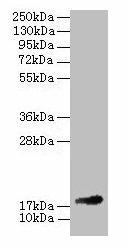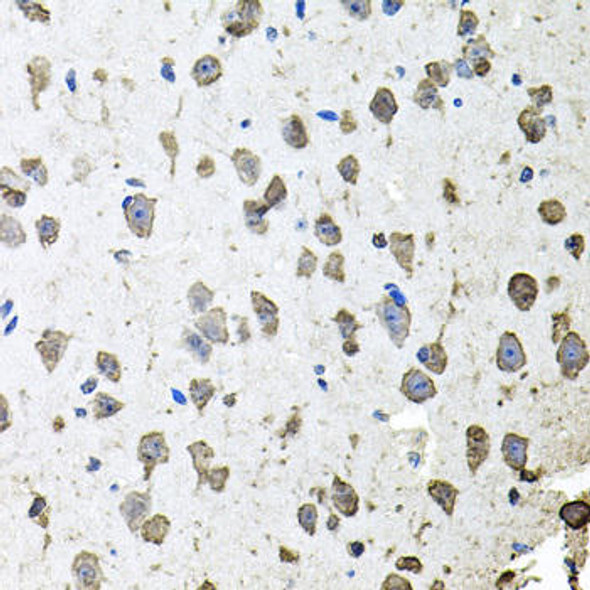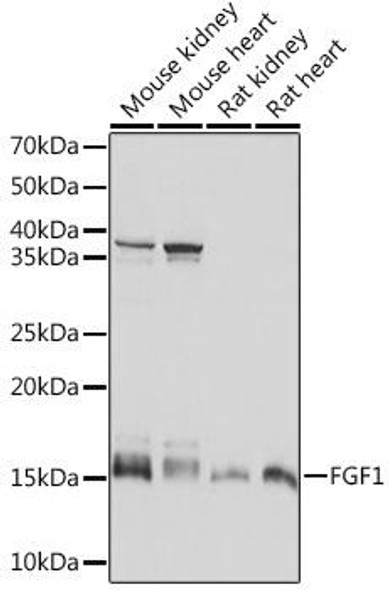Description
| Antibody Name: | Fgf1 Antibody (PACO26741) |
| Antibody SKU: | PACO26741 |
| Size: | 50ug |
| Host Species: | Rabbit |
| Tested Applications: | ELISA, WB, IHC |
| Recommended Dilutions: | ELISA:1:2000-1:10000, WB:1:500-1:5000, IHC:1:10-1:100 |
| Species Reactivity: | Mouse, Human |
| Immunogen: | Recombinant Mouse Fibroblast growth factor 1 protein (16-155AA) |
| Form: | Liquid |
| Storage Buffer: | Preservative: 0.03% Proclin 300 Constituents: 50% Glycerol, 0.01M PBS, PH 7.4 |
| Purification Method: | >95%, Protein G purified |
| Clonality: | Polyclonal |
| Isotype: | IgG |
| Conjugate: | Non-conjugated |
 | Western blot All lanes: Fgf1 antibody at 2µg/ml + 293T whole cell lysate Secondary Goat polyclonal to rabbit IgG at 1/10000 dilution Predicted band size: 18 kDa Observed band size: 18 kDa . |
 | Immunohistochemistry of paraffin-embedded human placenta tissue using PACO26741 at dilution of 1:20. |
| Background: | Plays an important role in the regulation of cell survival, cell division, angiogenesis, cell differentiation and cell migration. Functions as potent mitogen in vitro. |
| Synonyms: | Fibroblast growth factor 1 (FGF-1) (acid, c fibroblast growth factor) (aFGF) (Heparin-binding growth factor 1) (HBGF-1), Fgf1, Fgf-1 Fgfa |
| UniProt Protein Function: | FGF1: Plays an important role in the regulation of cell survival, cell division, angiogenesis, cell differentiation and cell migration. Functions as potent mitogen in vitro. Monomer. Homodimer. Interacts with FGFR1, FGFR2, FGFR3 and FGFR4. Affinity between fibroblast growth factors (FGFs) and their receptors is increased by heparan sulfate glycosaminoglycans that function as coreceptors. Found in a complex with FGFBP1, FGF1 and FGF2. Interacts with FGFBP1. Part of a Cu(2+)-dependent multiprotein aggregate containing FGF1, S100A13 and SYT1. Interacts with SYT1. Interacts with S100A13. Belongs to the heparin-binding growth factors family. 2 isoforms of the human protein are produced by alternative splicing. |
| UniProt Protein Details: | Protein type:Motility/polarity/chemotaxis; Cell development/differentiation; Cytokine Cellular Component: nucleoplasm; proteinaceous extracellular matrix; extracellular space; cytoplasm; extracellular region; nucleolus; cytosol; nucleus Molecular Function:heparin binding; protein binding; growth factor activity; Hsp70 protein binding; receptor binding; fibroblast growth factor receptor binding Biological Process: fibroblast growth factor receptor signaling pathway; positive regulation of transcription, DNA-dependent; multicellular organismal development; positive regulation of cholesterol biosynthetic process; cardiac muscle cell proliferation; cell proliferation; positive regulation of MAP kinase activity; positive regulation of angiogenesis; induction of an organ; positive regulation of cell division; positive regulation of cell proliferation; positive regulation of transcription from RNA polymerase II promoter; angiogenesis; positive regulation of protein amino acid phosphorylation; cell differentiation; positive regulation of epithelial cell proliferation; positive regulation of cell migration; lung development |
| UniProt Code: | P61148 |
| NCBI GenInfo Identifier: | 47117679 |
| NCBI Gene ID: | 14164 |
| NCBI Accession: | P61148.1 |
| UniProt Secondary Accession: | P61148,P10935, |
| UniProt Related Accession: | P61148 |
| Molecular Weight: | 17,418 Da |
| NCBI Full Name: | Fibroblast growth factor 1 |
| NCBI Synonym Full Names: | fibroblast growth factor 1 |
| NCBI Official Symbol: | Fgf1 |
| NCBI Official Synonym Symbols: | Fam; Fgfa; Dffrx; Fgf-1 |
| NCBI Protein Information: | fibroblast growth factor 1; aFGF; HBGF-1; acidic fibroblast growth factor; heparin-binding growth factor 1; fibroblast growth factor 1 (acidic) |
| UniProt Protein Name: | Fibroblast growth factor 1 |
| UniProt Synonym Protein Names: | Acidic fibroblast growth factor; aFGF; Heparin-binding growth factor 1; HBGF-1 |
| Protein Family: | Fibroblast growth factor |
| UniProt Gene Name: | Fgf1 |
| UniProt Entry Name: | FGF1_MOUSE |






